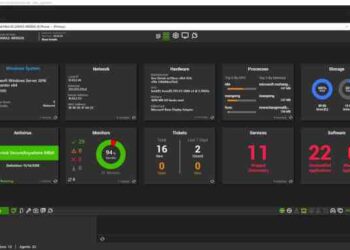Exploring the advantages of utilizing RMM tools for managed service providers, this introduction sets the stage for a comprehensive discussion on how these tools revolutionize IT management processes and enhance overall efficiency.
Delving into the key features and benefits, this paragraph aims to provide insightful information that will intrigue readers and highlight the importance of incorporating RMM tools in MSP operations.
Introduction to RMM Tools
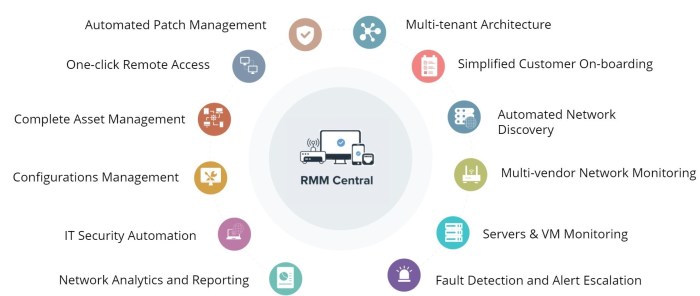
RMM tools, or Remote Monitoring and Management tools, are essential software solutions used by managed service providers to monitor, manage, and maintain IT systems remotely. These tools play a crucial role in the MSP industry by providing a centralized platform for overseeing clients' networks, devices, and endpoints.
Importance of RMM Tools in the MSP Industry
RMM tools are indispensable for managed service providers as they offer a wide range of functionalities that help streamline IT management processes. From monitoring system performance and security to automating routine tasks and generating reports, these tools enable MSPs to proactively address issues, ensure network stability, and deliver high-quality services to their clients.
- Remote Monitoring: RMM tools allow MSPs to remotely monitor clients' systems in real-time, enabling them to detect and address potential issues before they escalate.
- Automated Maintenance: These tools automate routine maintenance tasks such as software updates, patch management, and antivirus scans, reducing manual effort and minimizing downtime.
- Proactive Support: By providing proactive alerts and notifications, RMM tools empower MSPs to take preemptive action and resolve issues swiftly, enhancing overall client satisfaction.
- Performance Optimization: RMM tools help optimize system performance by identifying bottlenecks, monitoring resource utilization, and implementing performance-enhancing measures.
Key Features of RMM Tools
RMM tools offer a wide range of features that are essential for managed service providers to efficiently monitor and manage their clients' IT infrastructure. These tools help MSPs proactively address issues, ensure network security, and improve overall operational efficiency.
Remote Monitoring
RMM tools allow MSPs to remotely monitor the health and performance of their clients' systems in real-time. This feature enables MSPs to identify and address potential issues before they escalate, reducing downtime and improving customer satisfaction.
Automated Patch Management
Automated patch management is another key feature of RMM tools that helps MSPs keep their clients' systems up-to-date with the latest security patches and updates. This feature ensures that systems are protected against vulnerabilities and cyber threats, enhancing overall security posture.
Remote Access and Control
RMM tools provide MSPs with remote access and control capabilities, allowing them to troubleshoot and resolve issues on clients' systems without the need for physical presence. This feature saves time and resources by enabling quick problem resolution, leading to higher customer satisfaction.
Network Monitoring
Network monitoring is a crucial feature of RMM tools that allows MSPs to keep track of network performance, bandwidth utilization, and device connectivity. This feature helps MSPs proactively identify network issues and optimize performance, ensuring smooth operations for their clients.
Reporting and Analytics
RMM tools offer robust reporting and analytics capabilities that provide MSPs with valuable insights into system performance, security vulnerabilities, and compliance status. These reports help MSPs make informed decisions, optimize resource allocation, and demonstrate the value of their services to clients.
Improved Efficiency and Productivity
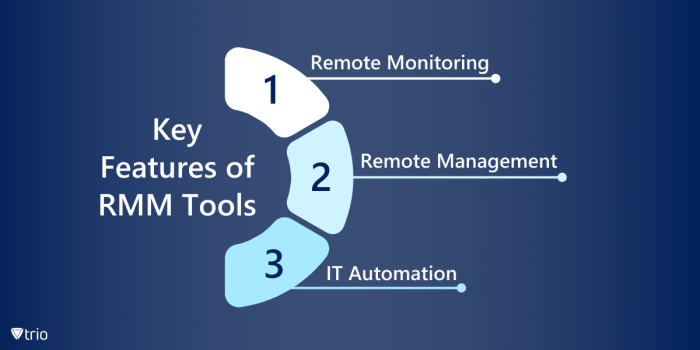
When it comes to managed service providers, using Remote Monitoring and Management (RMM) tools can significantly enhance efficiency and productivity in managing client systems.
Increased Automation and Monitoring Capabilities
RMM tools automate routine tasks such as software updates, patch management, and system monitoring. This automation reduces manual intervention, allowing MSP teams to focus on more strategic and complex issues.
- RMM tools enable proactive monitoring of client systems, detecting and resolving issues before they escalate, leading to improved system uptime and reduced downtime for clients.
- Automated alerts and notifications help MSP teams address issues promptly, leading to quicker resolution times and enhanced customer satisfaction.
- Centralized management through RMM tools provides a single dashboard for monitoring multiple client systems, streamlining operations and saving time for MSP teams.
Enhanced Security and Compliance Management
RMM tools offer robust security features such as antivirus management, endpoint protection, and security policy enforcement, ensuring that client systems are secure and compliant with industry regulations.
- Automated security scans and vulnerability assessments help MSP teams identify and remediate security threats in real-time, strengthening the overall security posture of clients.
- Compliance reporting features in RMM tools assist MSP teams in ensuring that client systems adhere to relevant regulations and standards, reducing the risk of non-compliance penalties.
Real-world Scenarios
In a real-world scenario, an MSP using RMM tools noticed a sudden spike in CPU usage on a client's server. The RMM tool automatically generated an alert, allowing the MSP team to investigate and resolve the issue before it impacted the client's operations, showcasing the proactive monitoring capabilities of RMM tools.
Enhanced Security Measures
Using Remote Monitoring and Management (RMM) tools can significantly enhance the security measures for Managed Service Providers (MSPs). These tools provide proactive monitoring and management of IT systems, allowing MSPs to detect and respond to security threats in real-time.
Detection and Resolution of Security Threats
RMM tools play a crucial role in detecting and resolving security threats before they can cause significant harm to a business. By continuously monitoring network activity, system performance, and security logs, these tools can identify any unusual or suspicious behavior that may indicate a potential security breach.
Once a threat is detected, RMM tools can automatically respond by isolating the affected systems, blocking malicious activities, and alerting IT staff for further investigation and resolution.
- Rapid Response: RMM tools enable MSPs to respond quickly to security incidents, minimizing the impact and reducing downtime for businesses.
- Threat Prevention: By implementing security protocols and automated responses, RMM tools can prevent security breaches such as malware infections, ransomware attacks, and data breaches.
- Compliance Monitoring: RMM tools help MSPs ensure that their clients' systems are compliant with industry regulations and security standards, reducing the risk of penalties and legal consequences.
Examples of Security Breaches Prevented by RMM Tools
One notable example is the prevention of a ransomware attack on a small business client by an MSP using RMM tools. The tools detected unusual file encryption activity and immediately isolated the infected systems, preventing the ransomware from spreading further.
Another instance involves the detection of a phishing email campaign targeting employees of a medium-sized company. RMM tools identified the malicious emails and blocked them before any sensitive information was compromised, safeguarding the company's data and reputation.
Remote Monitoring and Management
Remote monitoring and management (RMM) tools offer numerous advantages for managed service providers. One of the key benefits is the ability to oversee and control IT systems from a remote location, allowing MSPs to efficiently manage multiple clients and devices without the need for physical presence.
Advantages of Remote Monitoring and Management
- Proactive Maintenance: RMM tools enable MSPs to identify and address potential issues before they escalate, reducing downtime and improving overall system performance.
- Issue Resolution: With real-time monitoring and alerts, MSPs can quickly respond to issues, troubleshoot remotely, and provide timely solutions to clients.
- Cost-Effective: By remotely managing IT infrastructure, MSPs can save time and resources that would have been spent on onsite visits, resulting in cost savings for both the provider and the client.
- Scalability: RMM tools allow MSPs to easily scale their operations and manage a growing number of clients and devices without compromising efficiency.
Best Practices for Utilizing Remote Capabilities
- Set Up Automated Monitoring: Configure RMM tools to monitor critical systems, applications, and network components automatically to ensure continuous oversight and timely alerts.
- Establish Remote Access Policies: Define clear guidelines and protocols for remote access to client systems to maintain security and compliance standards.
- Regularly Review and Analyze Data: Monitor performance metrics and reports generated by RMM tools to identify trends, detect anomalies, and optimize system configurations for better outcomes.
- Provide Remote Support Efficiently: Utilize remote control features of RMM tools to troubleshoot issues, install updates, and perform maintenance tasks without disrupting end users.
Scalability and Growth Opportunities
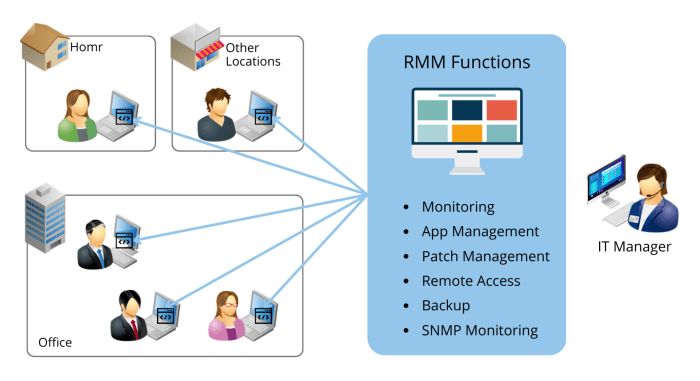
RMM tools play a crucial role in supporting the scalability and growth of Managed Service Provider (MSP) businesses. These tools offer a range of functionalities that enable MSPs to expand their service offerings, improve operational efficiency, and drive business growth.
Supporting Scalability
One of the key ways RMM tools support scalability is by automating routine tasks and processes. This automation allows MSPs to manage a larger number of endpoints and clients without significantly increasing their operational costs. By streamlining workflows and reducing manual intervention, MSPs can scale their operations more effectively and efficiently.
Expanding Service Offerings
RMM tools provide MSPs with the capability to expand their service offerings beyond traditional remote monitoring and management. These tools often include features such as patch management, network monitoring, and asset tracking, allowing MSPs to offer a wider range of services to their clients.
By diversifying their service portfolio, MSPs can attract new clients and increase their revenue streams.
Leveraging for Business Growth
By leveraging RMM tools effectively, MSPs can drive business growth and enhance their competitive edge in the market. These tools enable MSPs to deliver proactive IT support, improve response times, and enhance customer satisfaction. As a result, MSPs can build stronger relationships with their clients, increase customer retention, and ultimately grow their business through positive referrals and word-of-mouth recommendations.
Final Review
Concluding our exploration of the benefits of using RMM tools for managed service providers, it is evident that these tools play a crucial role in optimizing IT management, enhancing security measures, and fostering scalability for MSP businesses. Embracing RMM tools opens up a world of opportunities for growth and efficiency in the dynamic landscape of managed services.
Key Questions Answered
How do RMM tools enhance productivity for MSP teams?
RMM tools streamline IT management processes, automate routine tasks, and provide real-time monitoring capabilities, ultimately boosting productivity by allowing teams to focus on strategic initiatives rather than manual maintenance.
What are the security benefits of using RMM tools for MSPs?
RMM tools offer advanced threat detection, prompt issue resolution, and proactive security measures, safeguarding client systems and preventing potential security breaches effectively.
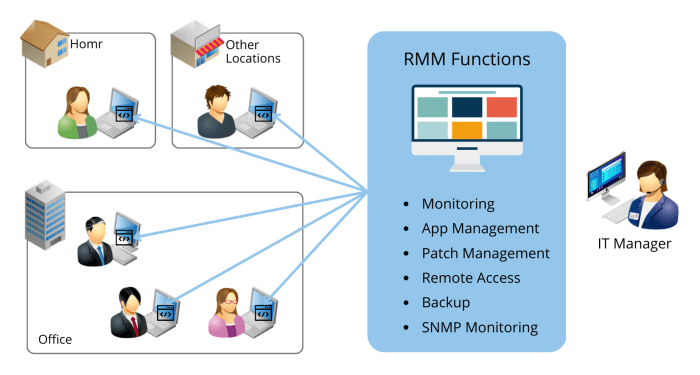




![Top 10 RMM Solutions [2024] | NinjaOne](https://ecommerce.mardinata.com/wp-content/uploads/2025/10/Best-RMM-Software-and-Tools-1-120x86.jpg)




